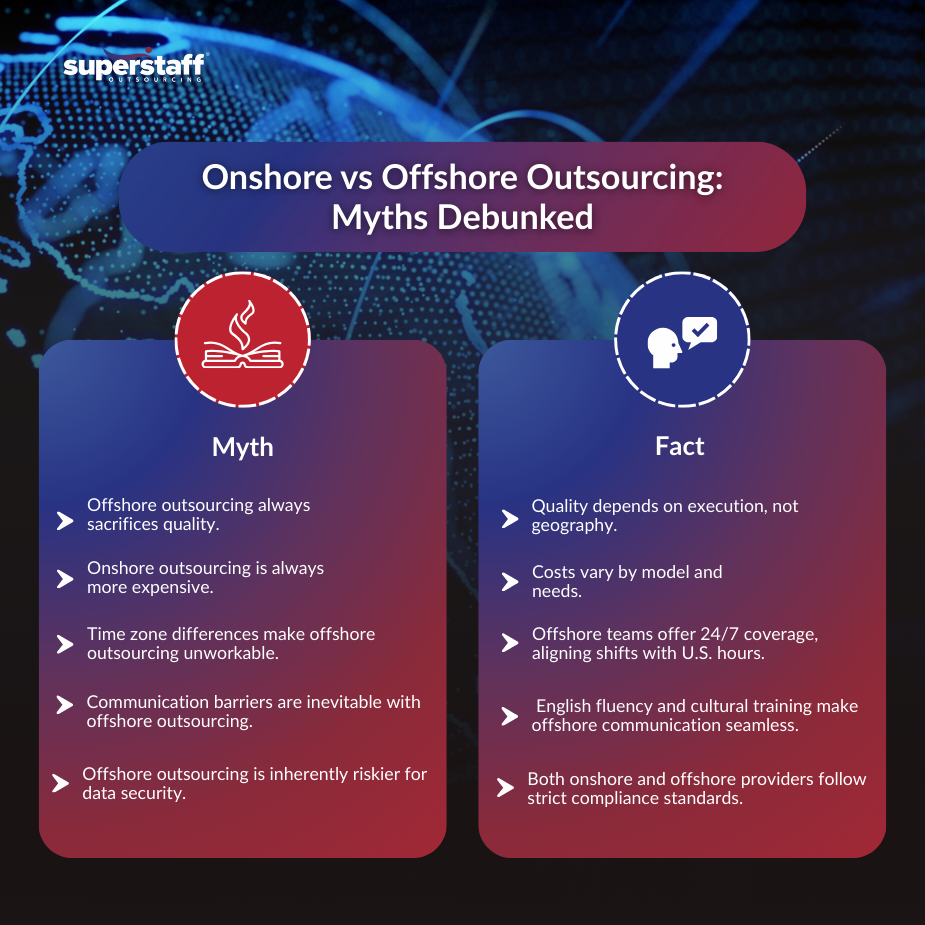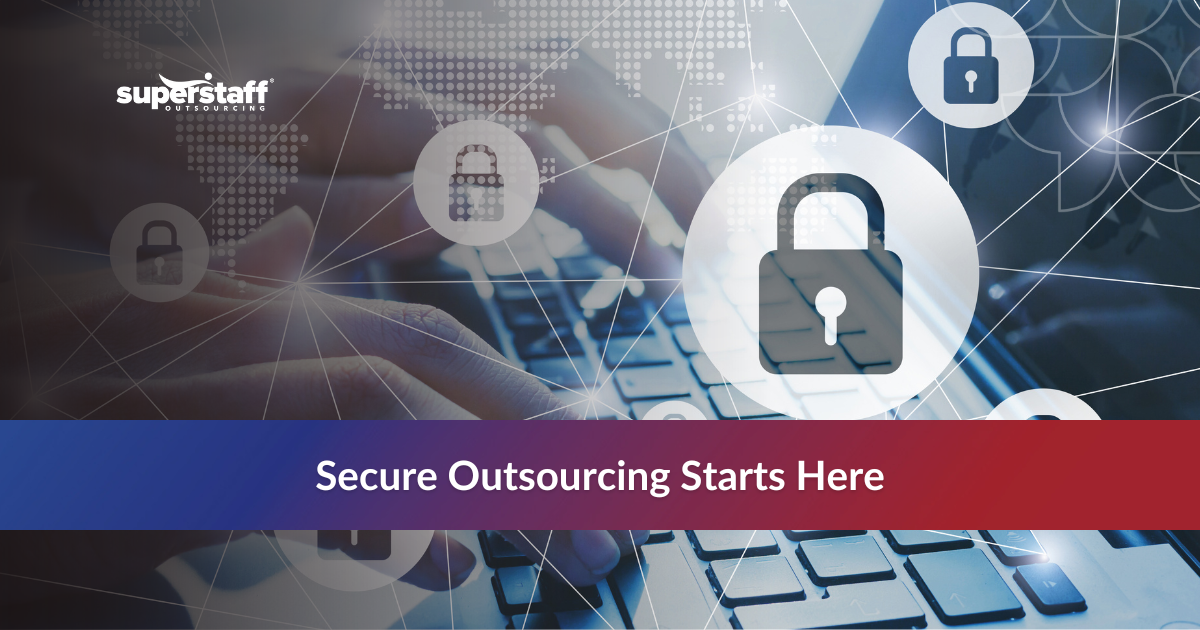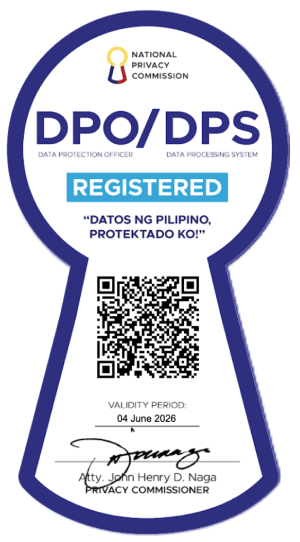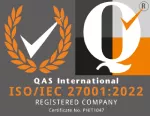
Many executives still make outsourcing decisions based on outdated assumptions, often relying on hearsay rather than hard evidence. This approach can limit opportunities and prevent companies from fully leveraging the benefits of outsourcing. The reality is that onshore vs offshore outsourcing is not a simple binary where one is always better than the other.
Each model brings its own strengths, and both can be highly effective when aligned with the right business goals. Unfortunately, misconceptions about cost, quality, communication, and risk often cloud the conversation, leading to decisions that miss the bigger picture.
By separating fact from fiction, businesses can cut through the noise and evaluate outsourcing models based on data and strategy rather than myths. This blog aims to clarify and correct the most common misconceptions surrounding onshore vs offshore outsourcing, giving decision-makers the clarity they need to choose models that truly support growth, efficiency, and long-term success.
Myth 1 — Offshore Outsourcing Always Sacrifices Quality
One of the most persistent myths about onshore vs offshore outsourcing debunked in modern business is the belief that offshore providers cannot deliver the same level of quality as onshore partners. This idea often stems from early outsourcing experiences decades ago, when companies rushed offshore purely to cut costs without investing in proper processes or governance.
Quality Depends on Governance, Not Geography
In reality, quality outcomes are less about location and more about provider selection, training, and performance management. Outsourcing firms—both onshore and offshore—succeed or fail based on how well they structure their teams, enforce processes, and meet client expectations.
Examples from the Philippines
When businesses outsource to the Philippines, for instance, they access a talent pool renowned for customer service excellence. Global brands in tech, retail, healthcare, and finance rely on Filipino teams not just for affordability, but for measurable quality. The country ranks highly in global English proficiency, with specialized training programs in technical support, customer experience, and industry compliance.
Global Standards and Certifications
Top outsourcing providers—whether located in Dallas or Manila—adhere to the same global standards. ISO certifications, Six Sigma practices, ITIL frameworks, and rigorous client SLAs ensure consistency and accountability. These benchmarks prove that quality is not tied to geography but to the operational discipline of the provider.
Poor Quality Exists Onshore Too
Just as there are high-performing offshore partners, there are also underperforming onshore providers. Businesses that fail to conduct due diligence, establish KPIs, or align expectations may encounter poor service, regardless of location.
While quality is a top concern, cost misconceptions are equally misleading.
Myth 2 — Onshore Outsourcing Is Always More Expensive
Another widespread misconception is that outsourcing locally (onshore) is automatically more costly than outsourcing overseas. The truth is far more nuanced.
Cost Structures Vary
The cost difference between onshore and offshore models depends on a wide range of factors: labor market conditions, infrastructure, training costs, and scalability needs. While wages may be higher in onshore markets, offshore contracts can carry hidden costs such as oversight, transition management, or vendor lock-ins.
Hidden Costs in Onshore Contracts
Onshore outsourcing often appeals to companies seeking proximity and cultural alignment, but those benefits can come with premium rates. However, costs escalate when unexpected overtime charges, local taxes, or regulatory burdens are factored in.
Offshore Savings Fuel Innovation
When businesses outsource to the Philippines or other offshore hubs, they unlock savings of up to 60% in labor costs. These savings don’t just pad the bottom line—they can be reinvested into research and development, marketing, or digital transformation initiatives. For many midmarket companies, this flexibility is critical to scaling faster than competitors.
Onshore Can Be Cost-Effective for Niche Needs
That said, onshore outsourcing is not always overpriced. In cases requiring highly specialized, regulated expertise—like government contracting or healthcare compliance—onshore providers may actually prove more cost-effective due to reduced risk and streamlined compliance.
Beyond cost, time zone differences are another misunderstood factor.

Myth 3 — Time Zone Differences Make Offshore Outsourcing Unworkable
Executives often worry that time zone mismatches will create inefficiencies when working with offshore teams. This belief ignores the many ways outsourcing partners have innovated around scheduling.
Benefits of 24/7 Coverage
Far from being a disadvantage, time zone differences can actually provide a competitive edge. Offshore outsourcing allows companies to implement follow-the-sun service models, ensuring around-the-clock customer support and business continuity.
Offshore Teams Align with U.S. Business Hours
When companies outsource to the Philippines, they often discover that agents are accustomed to working night shifts aligned with North American schedules. Entire labor ecosystems are built around this alignment, reducing concerns about overlap.
Hybrid Nearshore + Offshore Models
Businesses today also leverage hybrid models—splitting functions between nearshore centers (for real-time collaboration) and offshore teams (for cost efficiency and 24/7 coverage). This flexibility makes the onshore vs offshore outsourcing comparison less of an “either-or” and more of a spectrum of options.
Communication challenges are another frequently cited, yet often overstated, drawback.
Myth 4 — Communication Barriers Are Inevitable with Offshore Outsourcing
The idea that offshore outsourcing leads to constant misunderstandings and miscommunications is another outdated stereotype.
English Fluency in Offshore Markets
The Philippines, for example, is one of the largest English-speaking nations in the world. Its BPO sector has thrived precisely because of its high level of language proficiency and cultural affinity with Western markets.
Cultural Compatibility Programs
Beyond language, offshore providers invest heavily in cultural training. This includes accent neutralization programs, cross-cultural workshops, and industry-specific simulations that help agents mirror the communication style of their client base.
Technology Bridges the Gap
Modern collaboration platforms like Slack, Teams, and Zoom, combined with project management tools such as Asana or Jira, eliminate many of the barriers once associated with offshore outsourcing. Regular reporting dashboards and real-time analytics ensure clients remain in control of offshore operations.
Technology also plays a big role in dispelling security-related fears.
Myth 5 — Offshore Outsourcing Is Inherently Riskier for Data Security
Another common misconception is that outsourcing offshore exposes businesses to greater data security risks.
Compliance Is Global, Not Local
Both onshore and offshore providers must adhere to international standards like GDPR, HIPAA, and PCI DSS. Leading providers in the Philippines and India undergo regular ISO audits and maintain advanced cybersecurity protocols.
Security Audits and Safeguards
Offshore contracts now include strict clauses covering data handling, encryption, and breach response. These are no different from the security agreements signed with onshore providers.
Onshore Providers Face Risks Too
Data breaches are not exclusive to offshore vendors. In fact, some of the most high-profile breaches in recent years have originated from onshore companies. Risk comes from weak governance, not physical distance.
Now that we’ve covered the myths, let’s explore how businesses can choose objectively.
How to Evaluate Onshore vs Offshore Outsourcing Without Bias
To make the most of outsourcing, leaders must evaluate options based on strategy, not stereotypes.
Match Outsourcing to Business Goals
The right outsourcing model depends on whether your priority is cost reduction, market expansion, compliance, or innovation. For example, if your goal is to expand multilingual customer service, outsourcing to the Philippines offers clear advantages.
Hybrid Outsourcing Strategies
Instead of viewing onshore vs offshore outsourcing as mutually exclusive, many companies adopt hybrid models—keeping high-value, customer-facing tasks onshore while moving scalable operations offshore.
Partner Selection Criteria
Regardless of geography, partner selection should prioritize experience, certifications, employee training programs, and cultural compatibility. A structured RFP process, site visits, and pilot projects help reduce risk.
A fair, informed decision process ensures the right fit for any business.
Torn Between Onshore vs Offshore Outsourcing? Implement Hybrid BPO Strategies Through SuperStaff
Dispelling myths about onshore vs offshore outsourcing allows businesses to make smarter, more confident decisions. Quality, cost, time zones, communication, and security are not dictated by geography—they depend on execution, governance, and strategic alignment.
A clear onshore vs offshore outsourcing comparison shows that both models offer valuable benefits when applied to the right contexts. Offshore models, particularly when businesses outsource to the Philippines, provide unmatched scalability and cost efficiency, while onshore solutions may better serve highly regulated or niche industries.
Contact SuperStaff today to explore customized outsourcing strategies—whether onshore, offshore, or a hybrid model—that align with your unique business goals and ensure long-term growth.






